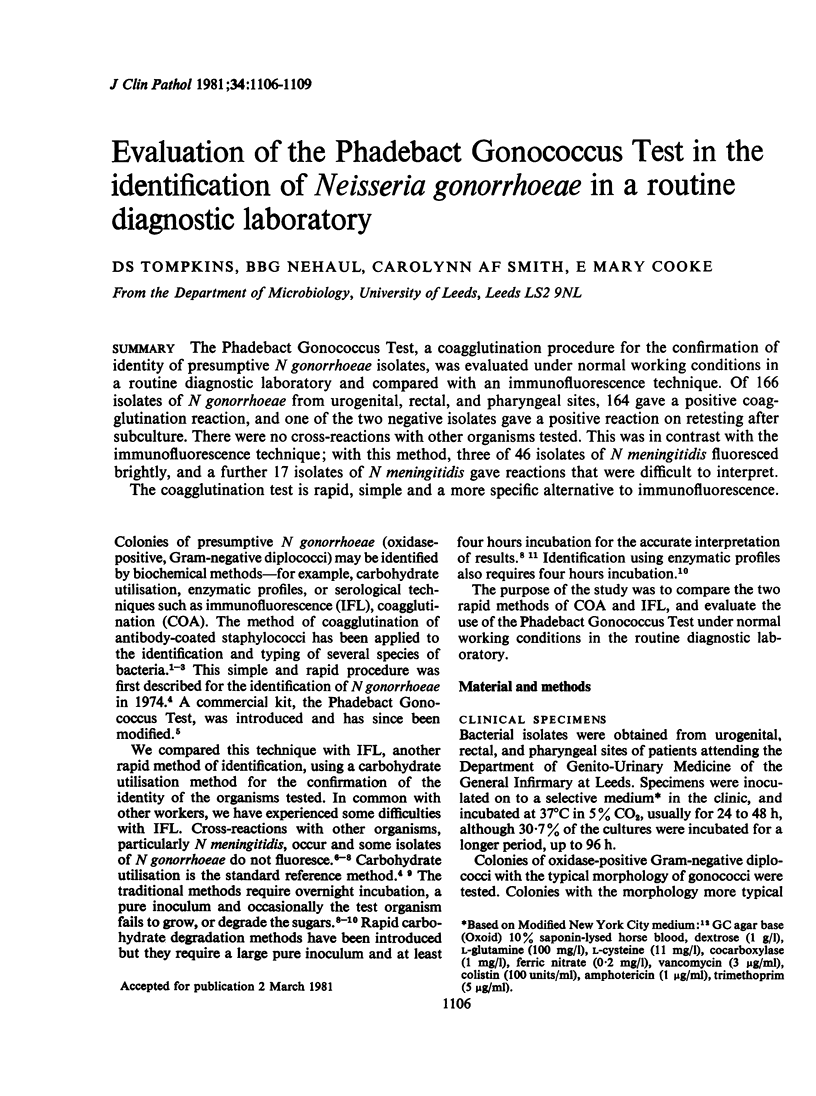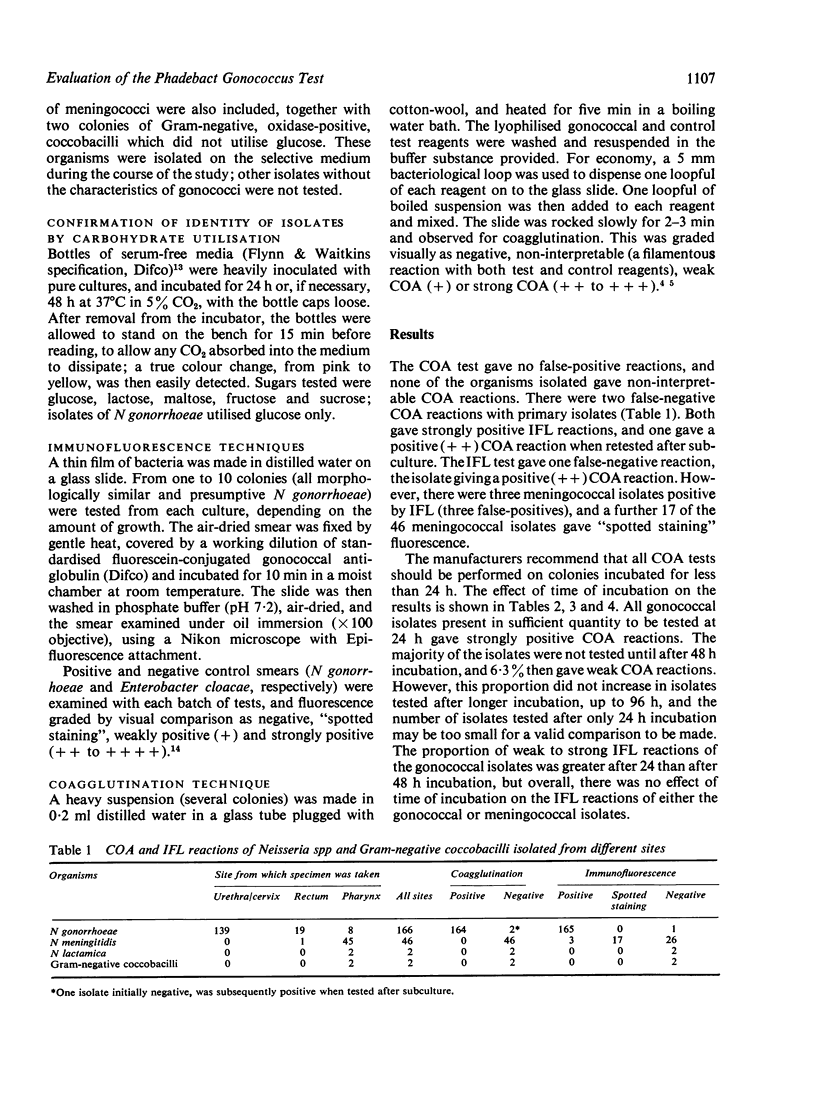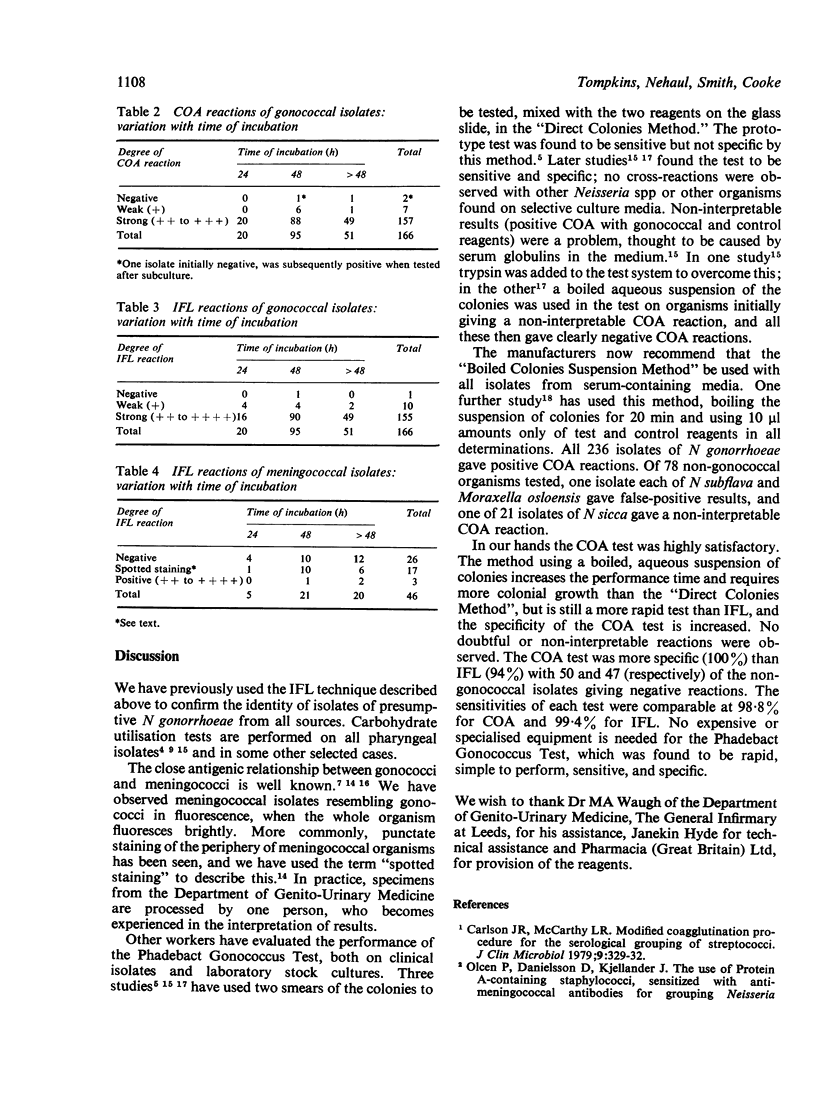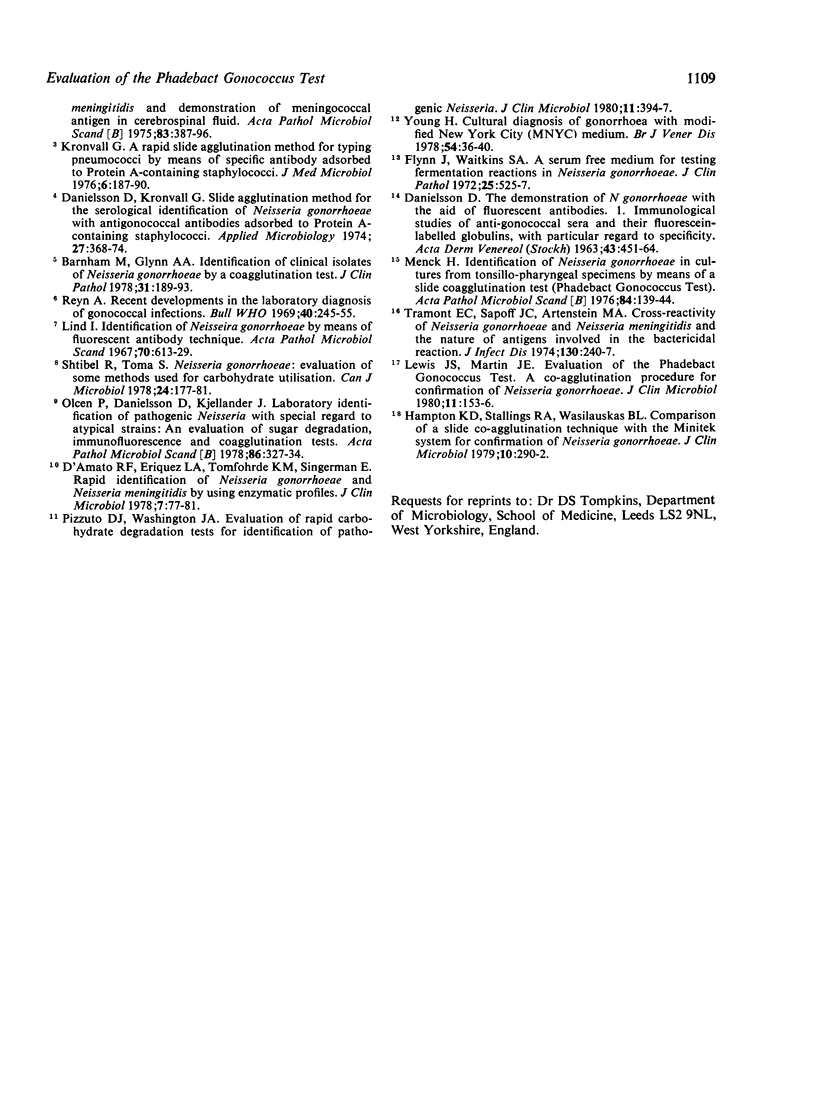Abstract
The Phadebact Gonococcus Test, a coagglutination procedure for the confirmation of identity of presumptive N gonorrhoeae isolates, was evaluated under normal working conditions in a routine diagnostic laboratory and compared with an immunofluorescence technique. Of 166 isolates of N gonorrhoeae from urogenital, rectal, and pharyngeal sites, 164 gave a positive coagglutination reaction, and one of the two negative isolates gave a positive reaction on retesting after subculture. There were no cross-reactions with other organisms tested. This was in contrast with the immunofluorescence technique; with this method, three of 46 isolates of N meningitidis fluoresced brightly, and a further 17 isolates of N meningitidis gave reactions that were difficult to interpret. The coagglutination test is rapid, simple and a more specific alternative to immunofluorescence.
Full text
PDF



Selected References
These references are in PubMed. This may not be the complete list of references from this article.
- Barnham M., Glynn A. A. Identification of clinical isolates of Neisseria gonorrhoeae by a coagglutination test. J Clin Pathol. 1978 Feb;31(2):189–193. doi: 10.1136/jcp.31.2.189. [DOI] [PMC free article] [PubMed] [Google Scholar]
- Carlson J. R., McCarthy L. R. Modified coagglutination procedure for the serological grouping of streptococci. J Clin Microbiol. 1979 Mar;9(3):329–332. doi: 10.1128/jcm.9.3.329-332.1979. [DOI] [PMC free article] [PubMed] [Google Scholar]
- Carlson J. R., McCarthy L. R. Modified coagglutination procedure for the serological grouping of streptococci. J Clin Microbiol. 1979 Mar;9(3):329–332. doi: 10.1128/jcm.9.3.329-332.1979. [DOI] [PMC free article] [PubMed] [Google Scholar]
- D'Amato R. F., Eriquez L. A., Tomfohrde K. M., Singerman E. Rapid identification of Neisseria gonorrhoeae and Neisseria meningitidis by using enzymatic profiles. J Clin Microbiol. 1978 Jan;7(1):77–81. doi: 10.1128/jcm.7.1.77-81.1978. [DOI] [PMC free article] [PubMed] [Google Scholar]
- DANIELSSON D. THE DEMONSTRATION OF N. GONORRHOEAE WITH THE AID OF FLUORESCENT ANTIBODIES. 1. IMMUNOLOGICAL STUDIES OF ANTIGONOCOCCAL SERA AND THEIR FLUORESCEIN-LABELLED GLOBULINS, WITH PARTICULAR REGARD TO SPECIFICITY. Acta Derm Venereol. 1963;43:451–464. [PubMed] [Google Scholar]
- Danielsson D., Kronvall G. Slide agglutination method for the serological identification of Neisseria gonorrhoeae with anti-gonococcal antibodies adsorbed to protein A-containing staphylococci. Appl Microbiol. 1974 Feb;27(2):368–374. doi: 10.1128/am.27.2.368-374.1974. [DOI] [PMC free article] [PubMed] [Google Scholar]
- Flynn J., Waitkins S. A. A serum-free medium for testing fermentation reactions in Neisseria gonorrhoeae. J Clin Pathol. 1972 Jun;25(6):525–527. doi: 10.1136/jcp.25.6.525. [DOI] [PMC free article] [PubMed] [Google Scholar]
- Hampton K. D., Stallings R. A., Wasilauskas B. L. Comparison of a slide coagglutination technique with the Minitek system for confirmation of Neisseria gonorrhoeae. J Clin Microbiol. 1979 Sep;10(3):290–292. doi: 10.1128/jcm.10.3.290-292.1979. [DOI] [PMC free article] [PubMed] [Google Scholar]
- Kronvall G. A rapid slide-agglutination method for typing pneumococci by means of specific antibody adsorbed to protein A-containing staphylococci. J Med Microbiol. 1973 May;6(2):187–190. doi: 10.1099/00222615-6-2-187. [DOI] [PubMed] [Google Scholar]
- Lewis J. S., Martin J. E., Jr Evaluation of the phadebact gonococcus test, a coagglutination procedure for confirmation of Neisseria gonorrhoeae. J Clin Microbiol. 1980 Feb;11(2):153–156. doi: 10.1128/jcm.11.2.153-156.1980. [DOI] [PMC free article] [PubMed] [Google Scholar]
- Lind I. Identification of Neisseria gonorrhoeae by means of fluorescent antibody technique. Acta Pathol Microbiol Scand. 1967;70(4):613–629. doi: 10.1111/j.1699-0463.1967.tb01330.x. [DOI] [PubMed] [Google Scholar]
- Menck H. Identification of Neisseria gonorrhoeae in cultures from tonsillo-pharyngeal specimens by means of a slide co-agglutination test (Phadebact Gonococcus Test). Acta Pathol Microbiol Scand B. 1976 Jun;84(3):139–144. doi: 10.1111/j.1699-0463.1976.tb01916.x. [DOI] [PubMed] [Google Scholar]
- Olcén P., Danielsson D., Kjellander J. Laboratory identification of pathogenic Neisseria with special regard to atypical strains: an evaluation of sugar degradation, immunofluorescence and co-agglutination tests. Acta Pathol Microbiol Scand B. 1978 Dec;86B(6):327–334. doi: 10.1111/j.1699-0463.1978.tb00052.x. [DOI] [PubMed] [Google Scholar]
- Pizzuto D. J., Washington J. A., 2nd Evaluation of rapid carbohydrate degradation tests for identification of pathogenic Neisseria. J Clin Microbiol. 1980 Apr;11(4):394–397. doi: 10.1128/jcm.11.4.394-397.1980. [DOI] [PMC free article] [PubMed] [Google Scholar]
- Reyn A. Recent developments in the laboratory diagnosis of gonococcal infections. Bull World Health Organ. 1969;40(2):245–255. [PMC free article] [PubMed] [Google Scholar]
- Shtibel R., Toma S. Neisseria gonorrhoeae: evaluation of some methods used for carbohydrate utilization. Can J Microbiol. 1978 Feb;24(2):177–181. doi: 10.1139/m78-030. [DOI] [PubMed] [Google Scholar]
- Tramont E. C., Sadoff J. C., Artenstein M. S. Cross-reactivity of Neisseria gonorrhoeae and Neisseria meningitidis and the nature of antigens involved in the bactericidal reaction. J Infect Dis. 1974 Sep;130(3):240–247. doi: 10.1093/infdis/130.3.240. [DOI] [PubMed] [Google Scholar]
- Young H. Cultural diagnosis of gonorrhoea with modified New York City (MNYC) medium. Br J Vener Dis. 1978 Feb;54(1):36–40. doi: 10.1136/sti.54.1.36. [DOI] [PMC free article] [PubMed] [Google Scholar]


